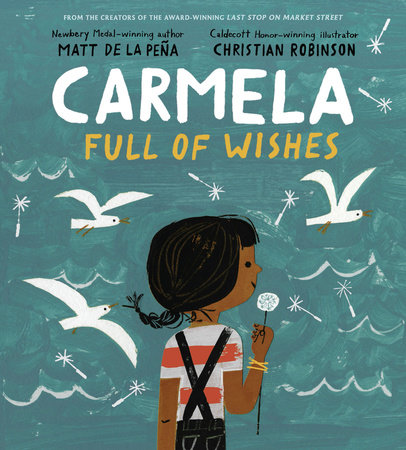The Creators of Last Stop on Market Street Are Back with a New Collaboration
by the Brightly Editors
When Matt de la Peña and Christian Robinson last collaborated on a picture book, we were given a New York Times bestseller, Newbery Medal winner, Caldecott Honor Book, and Coretta Scott King Illustrator Honor Book — we were given Last Stop on Market Street. Three years later, the talented duo is back to win over our hearts with a new picture book, Carmela Full of Wishes. With the poignant lyricism and artwork for which de la Peña and Robinson are known, this latest story portrays a child, her worries, and her wishes, and the diverse community that has shaped her.
Watch the video below (or scroll down to read the transcription of their conversation) to learn about the timely and personal inspiration behind the narrative and artwork of Carmela Full of Wishes.
Transcription of Matt de la Peña and Christian Robinson discussing Carmela Full of Wishes:
DE LA PEÑA: Hi, I’m Matt de la Peña, author of Last Stop on Market Street and our new book, Carmela Full of Wishes.
ROBINSON: And I am Christian Robinson, the illustrator of both Last Stop and Carmela Full of Wishes. Carmela Full of Wishes is a story about a young girl who lives in a migrant worker community and is really excited because it’s her birthday — and she’s finally old enough to go with her older brother to run some errands in their town. On their journey, she finds a dandelion growing out of the concrete and so she starts to imagine all the things she can wish for.
DE LA PEÑA: The basic concept of the story is very simple: The book is about sibling love and loyalty, and family. But there’s also like an undercurrent. Around nine million people living in America today are part of mixed-status families like Carmela’s, where at least one family member is undocumented, and we wanted to just tell a basic story that takes place in that community. My parents teach in a migrant community in California and just being around those kids, I wanted a story where they were the stars.
ROBINSON: I knew that when illustrating Carmela Full of Wishes I really wanted to do something really fun and playful with the wishes that she starts to imagine. So I thought, maybe I can do something different by using papel picado, which is a traditional Mexican craft where you kind of cut up tissue paper. And so that’s the way I tried to visualize each of Carmela’s wishes.
DE LA PEÑA: What made me excited about Christian’s art is I think he did such a great job just paying homage to the vibrancy of Mexican American culture and neighborhoods like Carmela’s.
ROBINSON: I haven’t seen many stories like Carmela Full of Wishes and I was really excited to tell a story that isn’t often seen in picture books. One of my favorite spreads is a moment when we get to see one of Carmela’s wishes. She wishes that her father could be home. But he isn’t because he’s not able to have his papers in order, because he’s been deported. I really connected with this moment in the story because, even though I don’t know what it’s like to have a parent taken away by deportation, I know what it’s like to have a parent taken away by a system.
I hope to connect with young readers and let them know that they’re not alone and that their experience and their story matters. To see a character like Carmela in a story could make a lot of difference to a lot of children. I know for me — what it made me feel — less alone and more connected.

